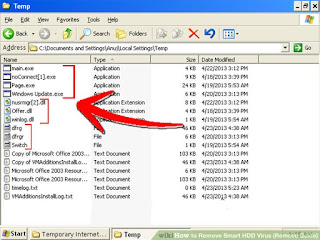Is a program designed to harm or cause harm on an infected computer. Its
spreads through e-mail attachments, portable devices, websites containing
malicious scripts and file downloads. A computer virus attaches itself to the
host files and always activate whenever you open the infected files. The virus
can replicate itself and then infect the other files on your computer causing
more damage. Below is a list of different types of computer viruses and what
they do.
DIFFERENT TYPES
OF INFECTIONS
MACRO VIRUSES
These viruses
infect the files created using some applications or programs that contain
macros such as doc, pps, xls and mdb. They automatically infect the files with
macros and also templates and documents that are contained in the file. They
hide in documents shared through e-mail and networks. Examples:
Relax
bablas
Melissa.A
MEMORY RESIDENT VIRUSES
They usually fix
themselves inside the computer memory. They get activated every time the OS
runs and end up infecting other opened files. They hide in RAM. Examples:
CMJ
meve
randex
OVERWRITE VIRUSES
These types of
viruses delete any information in a file they infect, leaving them partially or
completely useless once they are infected. Once in the computer, they replaces
all the file content but the file size doesn’t change. Examples:
Trj.Reboot
way
DIRECT ACTION VIRUSES
These viruses
mainly replicate or take action once they are executed. When a certain
condition is met, the viruses will act by infecting the files in the directory
or the folder specified in the AUTOEXEC.BAT. The viruses are generally found in
the hard disk’s root directory, but they keep on changing location. Example:
Vienna virus
DIRECTORY VIRUS
Also known as
cluster virus or file system virus. They infect the computer’s directory by
changing the path indicating file location. They are usually located in the
disk but affect the entire directory. Example:
WEB SCRIPTING VIRUS
Most web pages
include some complex codes in order to create an interactive and interesting
content. Such a code is often exploited to cause certain undesirable actions.
They mostly originate from the infected web pages or browsers. Examples:
MULTIPARTITE VIRUS
These type of
viruses spread in many different ways. Their actions vary depending on the OS
installed and presence of certain files. They tend to hide in the computer’s
memory but do not infect the hard disk. Examples:
flip
invader
tequila
FAT VIRUSES
These lardy
viruses attack the file allocation table (FAT) which is the disc part used to
store every information about the available space, location of files, unusable
space etc. Examples:
COMPANION VIRUSES
These types of
viruses infect files just like the direct action and the resident types. Once
inside the computer, they ‘accompany’ other existing files. Examples:
Asimov.1539
stator and terrax.1069
POLYMORPHIC VIRUS
They encode or
encrypt themselves in a different way every time they infect your computer.
They use different encryption and algorithms. This makes it difficult for the
antivirus software to locate them using signature or string searches (since
they are very different in each encryption). Examples:
Marburg
tuareg
Satan bug
elkern
WORM
This program is
very similar to a virus and has the ability to self-replicate leading to
negative effects on your computer. Examples:
lovgate.F
sobig.D
trile. C
PSWBugbear.B
Mapson
TROJANS
Trojans can
illegally trace important login details of users online. For example E-Banking
is very common among users, therefore, vulnerability of tracing your login
details whenever your PC is working without any strong powerful antivirus
installed.
EMAIL VIRUS
This is a virus
spread via an email. Such a virus will hide in an email and when the recipient
opens the mail.
BROWSER HIJACKER
This virus can
spread in many different ways including a voluntary download. If infects
certain browser functions especially in form of re-directing the user
automatically to certain sites. Example:
BOOT INFECTORS
They include the
boot sector plus master boot record types. All the viral codes can be separate
location; however they infect the hard disks or the floppy. Example:
DID YOU LIKE THIS
ARTICLE? Let me know your comments and thoughts.

















,%20Endpoint%20Detection%20and%20Response%20(EDR),%20and%20Extended%20Detection%20and%20Response%20(XDR).gif)

No comments:
Post a Comment